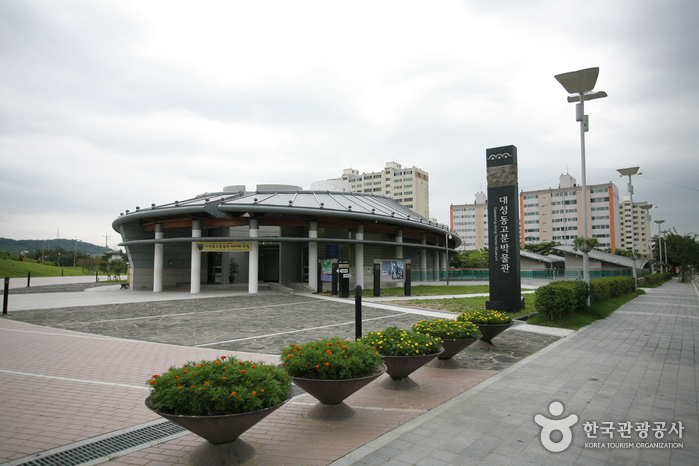Coach - Shinsegae Department Store Gimhae Branch [Tax Refund Shop] (코치 신세계백화점 김해점)
19.2Km 2024-04-18
2232, Gimhae-daero, Gimhae-si, Gyeongsangnam-do
-
Uniqlo - Shinsegae Gimhae Branch [Tax Refund Shop] (유니클로 신세계김해)
19.2Km 2024-04-23
2232, Gimhae-daero, Gimhae-si, Gyeongsangnam-do
-
Galaxy - Shinsegae Department Store Gimhae Branch [Tax Refund Shop] (갤럭시 신세계백화점 김해점)
19.2Km 2024-04-18
2232, Gimhae-daero, Gimhae-si, Gyeongsangnam-do
-
Shinsegae Department Store - Gimhae Branch [Tax Refund Shop] (신세계백화점 김해)
19.2Km 2024-04-23
2F Lotte Outlet Gwanggyo Branch, 10, Docheong-ro, Yeongtong-gu, Suwon-si, Gyeonggi-do
-
E-Mart - Gimhae Branch [Tax Refund Shop] (이마트 김해점)
19.2Km 2024-04-23
2F, 10, Docheong-ro, Yeongtong-gu, Suwon-si, Gyeonggi-do
-
Ancient Tombs in Daeseong-dong, Gimhae (김해 대성동 고분군)
19.2Km 2020-04-02
126, Gayaui-gil, Gimhae-si, Gyeongsangnam-do
+82-55-330-3934
The tumuli in Daeseong-dong, located to the east of the Royal Tomb of Kim Suro, reflect the formation and development of the Gaya Era. The Daeseong-dong Tumuli are located in the center of the shell mounds of Hoehyeon-ri, the location of the founding of the Gaya Kingdom according to local legend.
The tumuli relics were excavated by researchers from the Kyungsung University Museum from 1990 to 1992 and were found to be the common burial ground of the dominant class of the Gaya Kingdom. On the hilltops, which were viewed as prime burial places, are the tombs of kings and rulers; on the slopes are the tombs of the lower classes.
A total of 136 tumuli were found in the Daesong-dong area. Further investigation of the tumuli revealed several important and interesting facts. First, from the end of the third century, men and horses were buried alive along with the dead. Also, weapons were bent and buried as well, with many of these artifacts being unearthed among the tumuli. Other materials found in the tumuli such as cylindrical bronze items, pinwheel-shaped bronze items, and jasper items showed that Gaya was involved in trade with Japan. The Daeseong-dong Tumuli is significant in that it gives a glimpse into the political and social structure of the Gaya Kingdom, and the cultural exchange between Korea, China, and Japan.
Museum of the ancient tombs in Daseong-dong (대성동고분박물관)
19.2Km 2023-01-02
126, Gayaui-gil, Gimhae-si, Gyeongsangnam-do
+82-55-350-0401
The Museum of the ancient tombs in Daseong-dong displays artifacts unearthed from the four excavations of the Daeseongdong Tumuli. Highlighting often overlooked relics of the Geumgwan Gaya, the museum has three ground-floor exhibit halls and several underground auxiliary facilities. The main exhibits include a life-sized statue of a mounted soldier and a warrior statue, both recreated based on bones excavated from the tumuli of Yean-ri. The museum relies heavily on videos and dioramas to help visitors explore all the museum has to offer.
E-Mart Traders - Starfield Myeongji Branch [Tax Refund Shop] (이마트트레이더스 스타필드명지)
19.2Km 2024-04-22
168, Myeongjigukje 6-ro, Gangseo-gu, Busan
-
Van Ake - Starfield City Myongji Branch [Tax Refund Shop] (반에이크 스타필드시티명지점)
19.2Km 2024-06-27
168, Myeongjigukje 6-ro, Gangseo-gu, Busan
-
Olive Young - Starfield City Myeongji Branch [Tax Refund Shop] (올리브영 스타필드시티명지점)
19.2Km 2024-06-27
168, Myeongjigukje 6-ro, Gangseo-gu, Busan
-
![Coach - Shinsegae Department Store Gimhae Branch [Tax Refund Shop] (코치 신세계백화점 김해점)](http://tong.visitkorea.or.kr/cms/resource/32/2885932_image2_1.jpg)
![Uniqlo - Shinsegae Gimhae Branch [Tax Refund Shop] (유니클로 신세계김해)](http://tong.visitkorea.or.kr/cms/resource/34/2885934_image2_1.jpg)
![Galaxy - Shinsegae Department Store Gimhae Branch [Tax Refund Shop] (갤럭시 신세계백화점 김해점)](http://tong.visitkorea.or.kr/cms/resource/38/2885938_image2_1.jpg)
![Shinsegae Department Store - Gimhae Branch [Tax Refund Shop] (신세계백화점 김해)](http://tong.visitkorea.or.kr/cms/resource/62/2885962_image2_1.jpg)
![E-Mart - Gimhae Branch [Tax Refund Shop] (이마트 김해점)](http://tong.visitkorea.or.kr/cms/resource/33/2885933_image2_1.jpg)


![E-Mart Traders - Starfield Myeongji Branch [Tax Refund Shop] (이마트트레이더스 스타필드명지)](http://tong.visitkorea.or.kr/cms/resource/70/2889670_image2_1.jpg)
![Van Ake - Starfield City Myongji Branch [Tax Refund Shop] (반에이크 스타필드시티명지점)](http://tong.visitkorea.or.kr/cms/resource/41/3314741_image2_1.jpg)
 English
English
 한국어
한국어 日本語
日本語 中文(简体)
中文(简体) Deutsch
Deutsch Français
Français Español
Español Русский
Русский